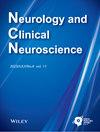Cerebral creatine deficiency syndrome with a novel missense variant in SLC6A8 gene
IF 0.4
Q4 CLINICAL NEUROLOGY
引用次数: 0
Abstract
Cerebral creatine deficiency syndromes (CCDS) are three metabolic diseases characterized by loss of function in three proteins (GATM, GAMT, and SLC6A8) that required in creatine (Cr) synthesis pathway and transport. In this study, we aimed to identify the causal variant in a male who was 12‐year‐old manifesting intellectual disability (ID), seizures, expressive dysphasia and autism‐like behavior. Urinary Cr metabolite measurements and MRI‐spectroscopy (MRS) findings were consistent with CCDS. Molecular analysis revealed de novo hemizygous SLC6A8 (NM_005629.4): c.1400 T > G (p.Met467Arg) variant. The variant was not found in ClinVar, (the date of access: April 23th, 2023) and population databases (ExAC, gnomAD, 1000 Genomes, ESP 6500, Turkish Variome, GenomeAsia, Iranome, GME Variome, TOPMed Bravo and 4.7KJPN), it alters the physicochemical properties of the amino acid, the region is moderately conserved across species and in‐silico prediction tools (REVEL, CADD, SIFT, PolyPhen2, Mutation Taster, MetaLR, MCAP, MetaRNN and MutPred) unanimously emphasize pathogenicity. Based on this evidence, the variant was interpreted as “likely pathogenic” according to the ACMG criteria (PS2, PM2,PP3, and PP4‐S). This report may further elucidate the nature and phenotypic consequences of SLC6A8 variants.SLC6A8基因一个新的错义变体引起的脑肌酸缺乏综合征
脑肌酸缺乏综合征(CCDS)是三种代谢性疾病,其特征是肌酸(Cr)合成途径和转运所需的三种蛋白质(GATM、GAMT和SLC6A8)功能丧失。在这项研究中,我们旨在确定一名12岁男性的因果变异,该男性表现出智力残疾(ID)、癫痫发作、表达性言语障碍和自闭症样行为。尿Cr代谢产物测量和核磁共振波谱(MRS)结果与CCDS一致。分子分析显示新的半合子SLC6A8(NM_005629.4):c.1400 T > G(p.Met467Arg)变体。在ClinVar(访问日期:2023年4月23日)和人群数据库(ExAC、gnomAD、1000基因组、ESP 6500、土耳其变体、GenomeAsia、Iranome、GME变体、TOPMed Bravo和4.7KJPN)中未发现该变体,它改变了氨基酸的理化性质,该区域在物种间适度保守,计算机预测工具(REVEL、CADD、SIFT、PolyPhen2、突变品尝器、MetaLR、MCAP、MetaRNN和MutPred)一致强调致病性。基于这一证据,根据ACMG标准(PS2、PM2、PP3和PP4-S),该变体被解释为“可能致病”。本报告可能进一步阐明SLC6A8变体的性质和表型后果。
本文章由计算机程序翻译,如有差异,请以英文原文为准。
求助全文
约1分钟内获得全文
求助全文

 求助内容:
求助内容: 应助结果提醒方式:
应助结果提醒方式:


